Fishing with Leica M: TTArtisan 11/2.8 Fisheye M-Lens Review
Lurking to go wider in the field of view and adding creative impact into your photo composition? Then you might be thinking about a fisheye lens. Fisheye lenses in general come in different focal length versions according to the sensor size and to the desired field of view: 8 mm fisheye lenses for full-frame sensors provide a circular image whereas focal lengths between 11 to 15 mm keep the rectangular full-frame ratio but are more curved towards the borders of the frame. Fisheye lenses significantly differ from so-called rectlinear "standard" wide lenses where straight lines are excessively extended between 10 to 12 mm focal length but are never curved. Fisheye lenses often allow to get really close to the subject in the frame further emphasizing the "bubble" effect. It can lead to unusual but very creative photo compositions.
Before 2020, Leica M users were out of luck finding any M-mount based fisheye lens on the market: workarounds were necessary like adapting a SLR-based fisheye lens to any Leica camera. Assuming the (D)SLR lens had an aperture ring or was at least attached with fixed aperture to the camera, the photographer still had to estimate the field of view on a film camera or digital camera without display/EVF. Newer and better corrected fisheye lenses in general are also expensive - the Canon 8-15/4 EF fisheye lens still goes for approx. $1200. Attaching a larger SLR-based fisheye lens to a Leica M camera is quite a bit front-heavy setup.
Since a few years, several Chinese lens manufacturers are penetrating the M-lens market with better and better manual focus lens quality for very reasonable prices. The companies started out competing with high in demand Leica and Zeiss M-mount lenses. This strategy seems to work - the Chinese lens manufacturers started to add additional M lenses (and other MLC-based mounts) where they see a lack in the market. One Chinese company - TTArtisan - released a novel 11/2.8 fisheye lens in different mounts including the M-lens mount in 2020. the aperture of f/2.8 is fast for a fisheye lens - even more surprising was its fairly low introduction price of $215 for MLC mounts and $370 for the M-mount versions. The quite significant difference in price for the M-mount version remains sort of a mystery.
I recently ordered this lens - I haven't tested one of the newer Chinese M-lenses before, so this was my first Chinese M-lens. Honestly, I was sceptic thinking this is too good to be true and kept my expectations quite low. I found a good deal online for a mint version of this lens in M-mount which as bonus came together with the 11 mm external viewfinder (normally an accessory which needs to be purchased separately). For the amount of money I spent to purchase, I could easily resell it to give me peace of mind. So I gave it a try.
The lens arrived in a white cardboard box - inside is another beautiful white hard case plastic box with black printed lens group design of the 11/2.8 lens on top of it. The lens sits securely inside a beautiful red padding. As technical person it is hard to impress me just by an exterior look, but I admit I was very impressed by it. This is well designed and marketed - and c'on, not even Leica's latest Noctilux 50/1.2 version comes in a red padded box ;)! Next I took the lens out of the box and instantly felt the weight - but in a positive way. This lens is extremely well built only with metal housing and lots of glass elements - but still comes ins a fairly small size for the focal length and the fast aperture. The lens cap is another impressive feature - made of metal and sits tightly around the front lens. Aperture and focus rings move smoothly. The labels on the lens are in white or yellow color and easy to read. Clearly this lens is made to imitate the Leica look. And it achieves this! I became very curious about its optical performance after being so impressed by its built.
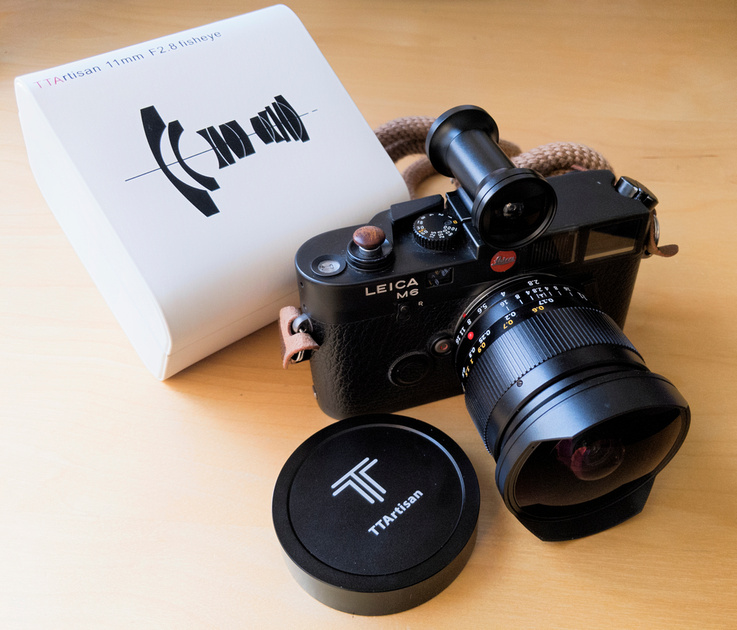

TTArtisan 11/2.8 M-lens with Leica M6 camera and external TTArtisan 11 mm viewfinder. The lens is delivered in a white plastic box including the lens design (behind camera).
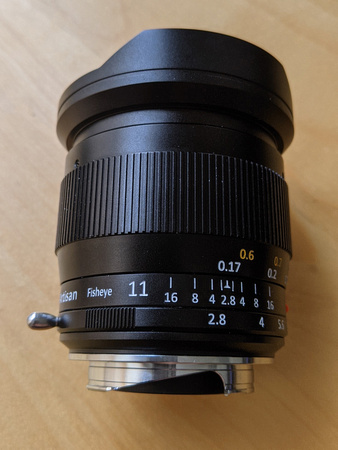

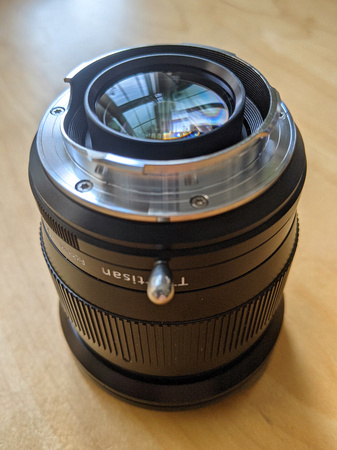

TTArtisan 11/2.8 M-lens from top with focus ring at MFD of 0.17 m and metal focus tab for the aperture ring (left). The back of the lens shows the M-mount with protruding back lens element (right).
First I attached this lens to my digital M-E 240 camera which I used for testing with the hotshoe-based VF-2 EVF. This way I wanted to make sure that I nail the focus to determine image sharpness by looking through the EVF. Since the lens is not rangefinder-coupled, I had to manually press the camera's focus button to magnify the focus image when moving the lens focus ring. I ventured outdoors on a cold winter day to take a couple first ultrawide photos of boats and a forklift nearby. I took them wide open at f/2.8 and stopped down to f/5.6, also at close focus about 0.17 m and more than one meter distance. I was impressed by looking at the EVF screen with my first results. Later I reviewed both the DNG and JPG files on my large monitor screen only confirming my initial impression. Not only is this lens very sharp wide open in the center, it provides a fantastic out-of-focus blur of the background. It is something I did not expect from a f/2.8 lens. This kind of blur I am used to see with faster f/1.4 lenses normally. Difference is that this fisheye lens does not show bokeh circles often - instead it blurs out image parts in a painterly smooth way. I would describe it as 3D effect which this lens provides wide open. Stopped down, the corner-to-corner sharpness improves significantly and is already very good at f/5.6. Aperture f/5.6 is a good choice to keep the viewer's eye focused on the extended main part of the image but leaving infinity background a bit blurry. At f/8.0, all image elements are super sharp including the corners of the frame. I observed some very slight blue and greenish chromatic aberration far out in the corners against the light source when magnified to 200% - easily to be corrected in post-processing. And honestly, this is normal for any kind of such ultrawide fisheye lens and nothing to worry about. Not much post-processing had to be done with the photos - just adding a bit contrast and saturation which I normally do with digital files anyway no matter which lens I am using.


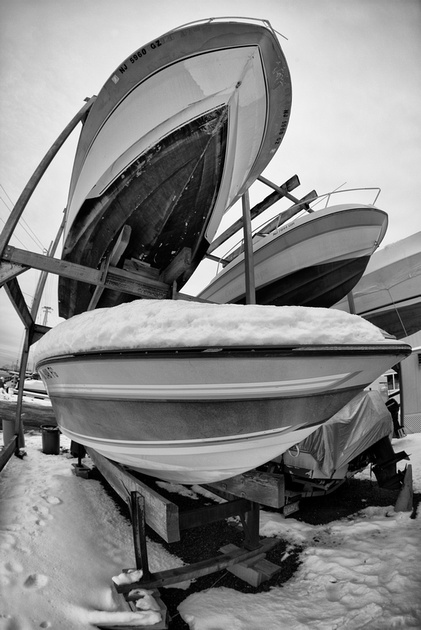

TTArtisan 11/2.8 M-lens with Leica M-E 240 camera: wide open at f/2.8 (left) and stopped down to f/5.6 (right)


The 180 deg field of view and getting close to the tire in the photo above includes the tracks in the snow behind it. Monochrome digital photo taken at f/4.0
The M-mount version comes with a handy metal aperture ring tab which other MLC mount versions don't seem to have. I am normally not a big fan of tabs, but here it is really helpful. The aperture ring is slim, and the tab allows easy handling. What I found as debit during practical use in this lens' construction is the lack of aperture click stops. By having the camera dangling from my neck, I found that the aperture ring started after a while moving on its own forcing me to check my aperture setting before taking another photo. No aperture click-stops might be beneficial for video usage though. The focus ring has a good size and moves easily. Using this lens in colder outdoor temperature stiffened a bit the movement of the focus ring. No concern but I could clearly tell the difference. The required movement of the focus ring is longer at minimum focus distance (MFD) - allowing better precision focus at close-up distance.
Lack of rangefinder focus coupling worried me first, but I learned quickly that it is not needed with this lens. This can be easily performed by zone focusing to one meter or infinity and a mid-size choice of aperture. More critical focus is needed for distances below 0.5 m - and rangefinder focusing doesn't work anyway below 0.7 m! Here either EVF/LiveView is required for best accurate focusing, or a good estimate. I figured that the MFD of this lens at 0.17 m is just about a hand length of mine - so I estimated quite well the distance between subject and lens with my hand at MFD and then released the shutter. This method proved very useful with film and using a wider lens aperture.


Best close-up focus can be obtained with EVF or LiveView display. Taken with M-E 240 camera and VF-2 EVF at f/2.8.
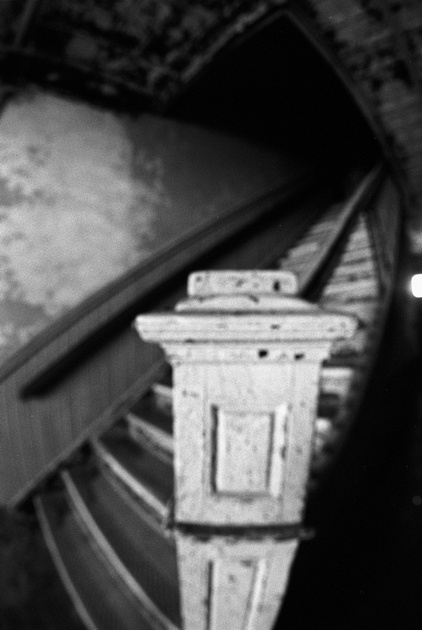

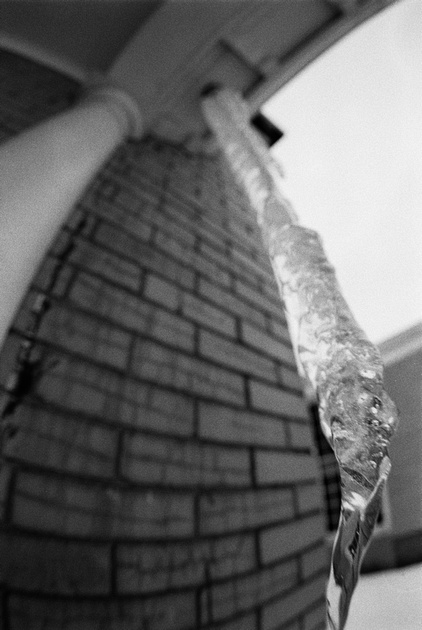

Accurate close-focusing can be challenging at times without EVF or LiveView display as in these two cases above taken with my Leica M6 film camera and 11 mm external viewfinder mounted on the hotshoe. Closest focus distance is about 17 cm which corresponds to about a hand length. Still a bit out of focus (left) at f/2.8, stopping down makes it easier to focus accurately at f/4.0 (right).
After seeing this lens' performance on digital in color, I was curious to see it performing on film - especially B&W film. Main reason was also to test the 11 mm external TTArtisan viewfinder which I received together with the lens but which is normally an accessory to purchase separately. The 11 mm viewfinder is also fully made of metal with glass element(s) inside representing the ultrawide 11 mm view. The hotshoe mount sits well on my Leica M6 but loosened itself once in the camera bag and fell off. Reason for this is that the viewfinder mount doesn't fully insert onto the M6 camera's hotshoe mount - it hits the pin on the mount and sits a couple mm short of inserting fully on the hotshoe plate. This does not affect functionality though - The external viewfinder is quite long with > 5 cm in length. I personally like that the lens element to look through is protruded inside the barrel, so you will never touch and smear it. The shown view fits very well to the one in the final photograph. It is a great tool to compose with especially on film cameras. To me it has become quickly a must-have accessory in combination with this lens. I also tested if this viewfinder could be used to resemble the 12 mm view of my Voigtlander 12/5.6 M-mount rectlinear lens - but the 1 mm difference in focal length makes a big difference in frame size! This means the 11 mm viewfinder remains dedicated to this one lens only.
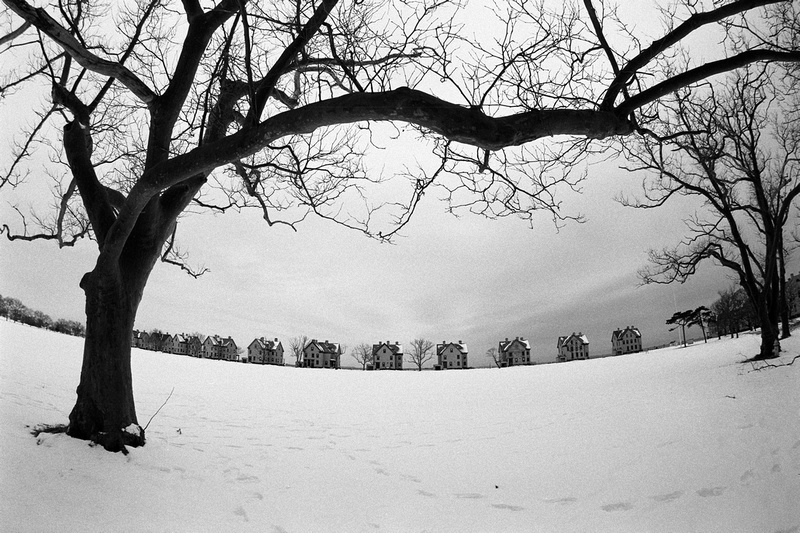

TTArtisan 11/2.8 M- lens with Leica M6 and Ilford FP4+ 125 film: fisheye landscape photos compress some elements and stretch others out at the same time. The curved horizontal line with the houses adds uniqueness to the image. Taken at f/8.0.
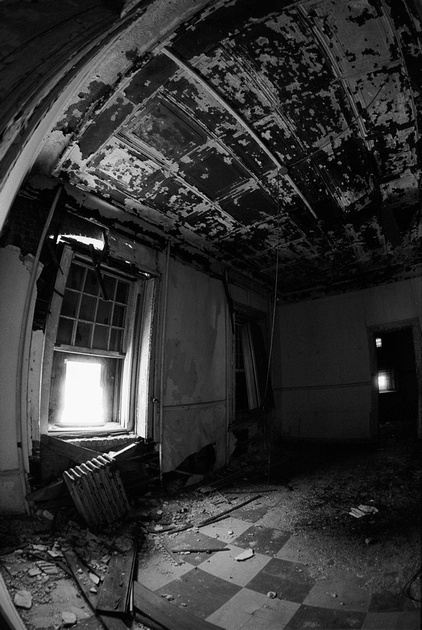



Lens curvature with this fisheye lens can add drama and show common forms from a different perspective. Film photos taken at f/2.8 (left) and f/5.6 (right)
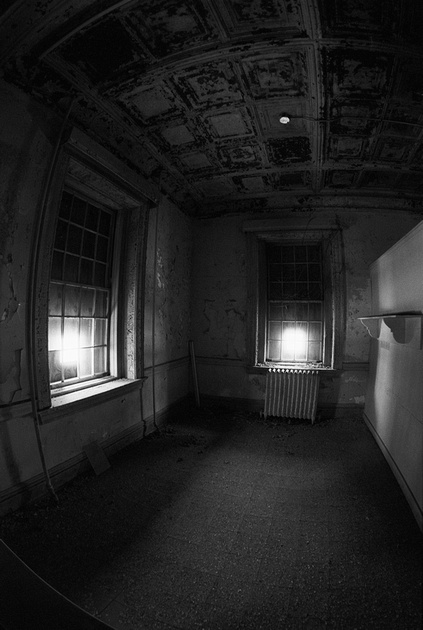

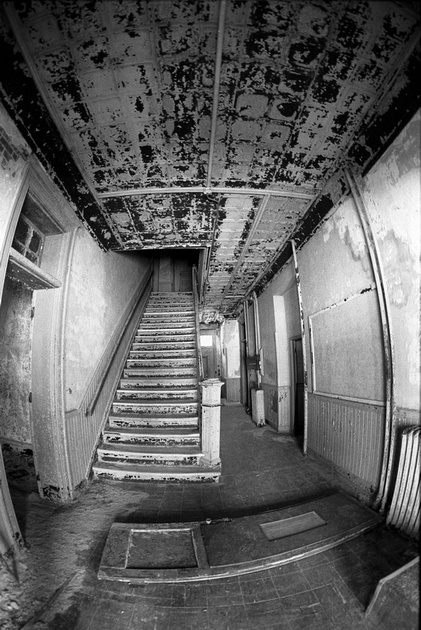

Low light performance of the TTArtisan 11/2.8 lens is very good. The film photos were taken handheld at f/2.8 and 1/8 sec exposure time with ISO 125 film.
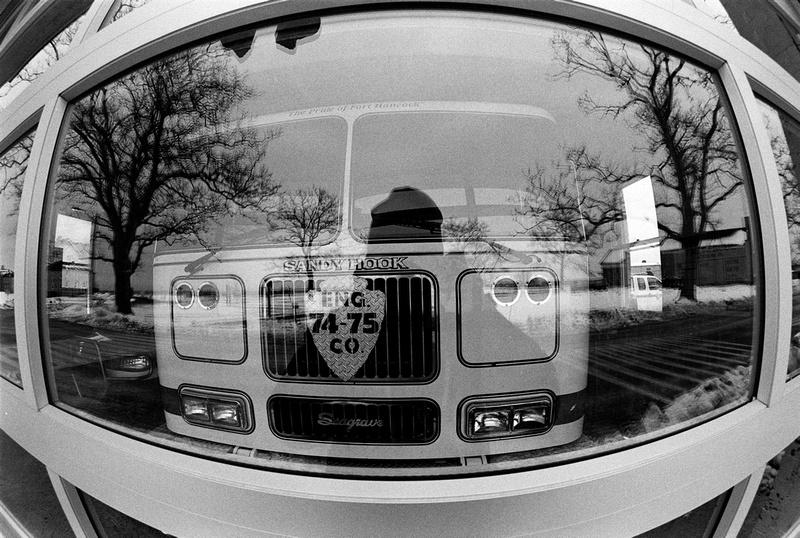

The lens allows for very close focusing distance - It was only a hand length apart from the window. The lens has a 180 degree field of view. Film photo taken at f/8.0
My film photos using the TTArtisan 11/2.8 lens fell nothing short of coming out perfect. I only lost a few frames when estimating the focus at closer focus distance wrongly. Here clearly digital with EVF is the much easier choice which guarantees accurate focus. But zone focusing at 0.5 meters up to infinity turned out well at different apertures. I found myself this day in a situation shooting indoors in dim light - f/2.8 was just right with my ISO 125 film and 1/8 sec exposure time to get the handheld shots (I was never able to get sharp photos at 1/8 sec with my (D)SLRs but it is doable with my rangefinder cameras!). The lens is fairly flare resistant - I used it with light sources in the center and one the side and didn't see any flares or undesired reflections.
The lens makes your brain work a bit harder and also be more creative in your compositions. You can't use this lens like any other rectlinear lens - if you do, all you get are boring and/or too distorted lines in the image. I found it key to get close with this fisheye lens - much more dramatic compositions are possible this way. This lens combines fisheye with close-up features which makes it even more interesting. Often I found myself in shooting from low ground upwards with this lens to increase dramatic view in the composition. The lens can be used for indoor shots with creative input - for example closer objects on the side of the 11 mm fisheye view appear bigger than they are, and objects which are in the center appear less distorted but smaller. There are ways to remove the typical curved fisheye distortion from the image yielding in a rectlinear look-alike. But where is the fun with this? If I want straight lines, I would rather grab my Voigtlander 12/5.6 lens instead. When shooting fisheye, I embrace the distortions!
I quickly decided that this lens is a keeper lens for me! It is very unique and is optically IMO miles better than what you would expect from the lens price. That it comes with f/2.8 stop is an additional benefit for low light situations, great for shallow depth of field effects, and when shooting with film. I mentioned earlier the price difference of this lens in different mounts with M-mount being the significantly more expensive one. Since the flange distance of rangefinder camera is smallest, likely some difference placing the lens groups into the corresponding lens housing helps to overcome potential culprits with rangefinder cameras. Some additional extra feature like the aperture tab adds to the increased price for the M-lens - other than potential higher demand for the M-mount lens in the first place. This being my first experience with a Chinese M-mount lens, I am actually curious now about others they have in their program.
I summarized my main findings in bullet points below, but the cons are minor issues which shouldn't stop anybody going for this lens.
Pros
+ Extremely well built lens with metal body delivered in a beautiful padded box
+ Still compact lens size for the f/2.8 aperture speed and the number of lens elements used
+ Well-made metal lens cap which sits securely on the front lens
+ High optical quality of the lens
+ Manual focus ring allows for accurate focusing at closer focus distances
+ Painterly 3D effect wide open and with close focus subject
+ Suitable to shoot in dark environments wide open
+ Aperture metal tab on otherwise slim ring
+ 11 mm External viewfinder available as accessory
+ Excellent price/quality ratio
Cons:
- No aperture click-stops: aperture ring can accidentally move on its own while carrying the camera
- No rangefinder focus coupling even it is not really needed with this lens. But It would be a nice-to-have!
- Stiffer lens movements (aperture and focus rings) in cold temperatures
- 11 mm External viewfinder doesn't fully insert into the Leica M6 hotshoe making it a bit loose (but not severely, it won't fall off easily)
- No paper manual provided - only a card with links to the TTArtisan website (no manual there either!). But who reads lens manuals?!
- M-lens mount of this lens is much more expensive than other MLC-based mounts